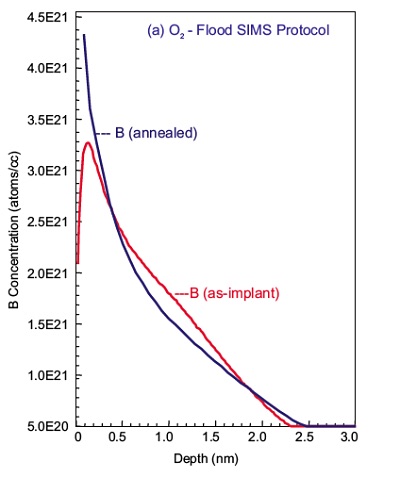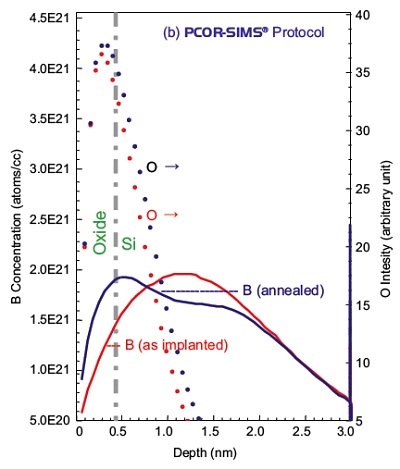Characterizing Annealed ULE B Implants
Home » Characterizing Annealed ULE B Implants
Development and improvement of Ultra Low Energy (ULE) boron ion implantation is an area of intense interest as device dimensions continually shrink. Characterization of these implants requires accurate profile shape and oxide layer thickness within the upper several nanometers of the wafer surface.
PCOR-SIMSSM represents the latest improvements in ULE B characterization that incorporates point-by-point data corrections for all regions of the profile. This method avoids near-surface profile distortions introduced by the older oxygen flooding and normal incidence techniques and yields the most accurate junction depth measurements due to precise measurement of surface oxide thickness.
DISCUSSION
The difference between old and new protocols is dramatically shown in the profiles above of a 250eV as-implanted and annealed Si wafer. Near surface artifacts in the old O2-flood and normal incidence protocols severely distort the B profile shape of both the as-implanted and annealed profiles.
In contrast, the PCOR-SIMS® protocol shows that the as-implanted sample has a Gaussian-shaped peak only 1.3nm below the surface.


The annealed sample shows redistribution of B to the interface between the surface oxide layer and the Si substrate, in agreement with existing thermodynamic diffusion models at the Si/SiO2 interface1. In addition, the PCOR-SIMS® profile also gives a quantitative measure of the surface oxide thickness, a feature that is lacking entirely from the O2-flood and normal incidence profiles. Note that there has been little change in the oxide thickness due to annealing despite significant diffusion of B.
* PCOR-SIMSSM for ULE B protocol is the result of extensive development efforts by EAG. The “PCOR-SIMSSM” name describes, in part, EAG’s proprietary methodology that includes point-to-point correction resulting in the most accurate SIMS profiling yet for ultra shallow implants.
Figure 1 and 2 show a comparison of two SIMS analysis protocols for 250eV boron implant characterization before and after anneal. Please note that concentration axes are linear unlike the usual log scales. PCOR-SIMS® analysis of annealed B implantation detects accumulation at oxide/Si interface as expected (b). Whereas O2-flood SIMS protocol results in un-realistic profile shapes (a).
1. Phys. Rev. B 68, 195311 (2003)
Would you like to learn more about Characterizing Annealed ULE B Implants?
Contact us today for your characterizing annealed ULE B implant needs. Please complete the form below to have an EAG expert contact you.